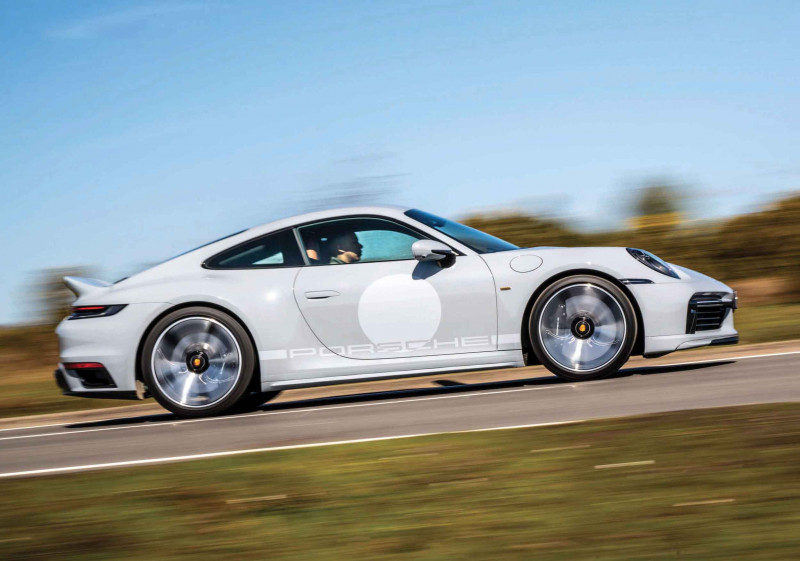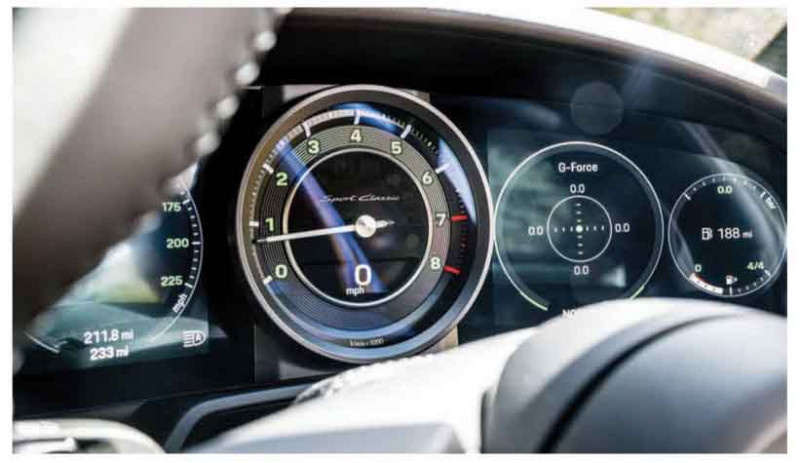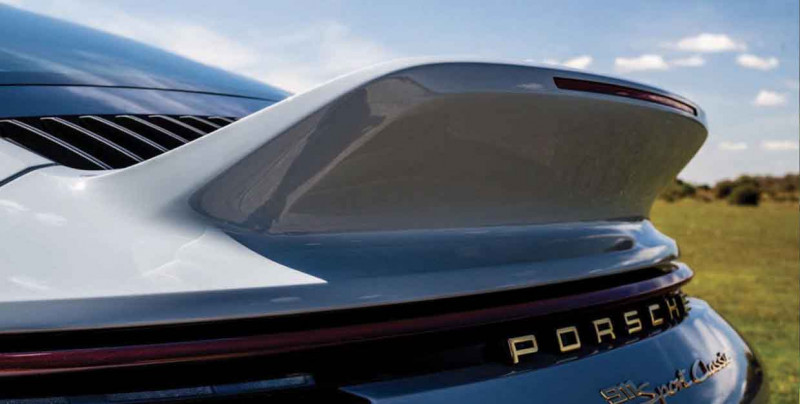2024 Porsche 911 Sport Classic 992
A may be a mishmash of parts, but this doesn’t stop the new 992 Sport Classic from being a highly desirable celebration of all things 911...
Words James Fossdyke
Photography Barry Hayden
CLASSIC PACKAGE
Sampling the new 992 Sport Classic
As the 911 celebrates its big birthday, it’s only right that we should mark the occasion with a series of celebratory articles in the pages of 911 & Porsche World. And without wishing to spoil the rest of this review too much, there’s no doubt the 911 Sport Classic is something to be celebrated.

In fact, it’s arguably the most purist-oriented model of the 992 generation thus far. Combining the attributes of the Turbo and GT3, it’s a limited-edition lovechild little short of epic. Let’s start with the styling, which follows on from the 997-based 911 Sport Classic of 2009 by taking inspiration from the iconic Carrera RS 2.7. The recipe is simple: take the wider Turbo shell, trim away accoutrements deemed supplementary to requirements, then add one or two glorious extras.


The Turbo’s instantly recognisable air intakes (just forward of the rear quarters), for example, have gone, which makes the rear end look that bit cleaner, despite the appointment of a ‘ducktail’ fixed spoiler. There’s the slightest hint of a double-bubble roof, too.
The wheels are painted to reflect the aesthetic of classic Fuchs, even if they’re significantly larger, measuring twenty inches across at the front and twenty-one inches at the back. Porsche has paid just as much attention to the colour scheme — the Sport Grey Metallic paint adorning our test car takes inspiration from Fashion Grey, offered on the 356. Other Sport Classic colours are available, including Black, Agate Grey Metallic and Gentian Blue Metallic, along with Paint to Sample choices. Whichever hue you choose, it will be decorated with racing stripes on the bonnet and roof, as well as along the bottom of the doors, unless you request otherwise.

Some of the nattiest features are the smallest. As a case in point, there are Porsche Exclusive Manufaktur badges on the front wings and a classic Porsche crest on the frunk. At the rear resides a circular Porsche Heritage badge. Regular readers will recognise it as a staple of Porsche’s retro-styled 992s, as demonstrated by the 992 Carrera 4S Targa Heritage Design Edition featured on the cover of the October 2021 issue of 911 & Porsche World. Here as then, the badge is colour-coded to the host 911.
You can have racing numbers applied to the Sport Classic’s door roundels, if that’s the kind of thing that excites you. Speaking of which, opening the doors leads you down yet another rabbit hole of discovery. Peer into the cabin and you’re presented with a three-tone scheme combining Black Nappa leather and Cognac semi-aniline leather with Pepita cloth.

Although ‘houndstooth’ was first used in the 356, it was only officially marketed by Porsche for the first-generation 911. Whatever Pepita’s provenance, the combination of colours and materials on display here is striking. It manages to bridge the retro/modern divide with ease, and this is without mentioning the wood dash trim and gold badge lettering, the latter reflecting the exterior badging.
Classic styling cues aside, pretty much everything in the cockpit is thoroughly modern. You get the same touchscreen, climate control and instrument display as you’d expect from a top-line 992, but there’s a new rev counter, which is styled to look considerably older than it is. The green digits are backlit, giving the impression they’re luminous. It’s a nod to the gauges in the 356, early 911 and the 912. Despite the retro design, however, the Sport Classic’s rev counter looks perfectly at home alongside the digital displays to its left and right.
Let’s be honest, all this is just set dressing. What really matters is the beating heart of the beast. Like the 992 Turbo, the Sport Classic’s back end is filled with a 3.7-litre twin-turbocharged flat-six, but here the similarities end. Instead of all-wheel drive, you get old-school rear-wheel drive. There’s a manual gearbox as standard, albeit one with seven forward speeds. And while this may be the most powerful manual 911 you can buy new from Porsche main dealers right now, this is clearly a 911 for enthusiasts, not statisticians. Nevertheless, let’s get into the numbers.
With 542bhp and 442lb-ft torque on tap, the Sport Classic has plenty of poke, but it’s less powerful than the Turbo. That shortfall in oomph, combined with the manual gearbox and the refusal to send any of the available power to the front wheels, has resulted in a significant drop in performance. Well, on paper, at least. Official figures show the Sport Classic accelerates from standstill to 62mph in 4.1 seconds, which is more than a second slower than the 992 Turbo. Perhaps more remarkably, the Sport Classic a mere tenth of a second faster than a stock 992 Carrera coupe. Then there’s the Sport Classic’s top speed of 196mph, which is 3mph down on the Turbo, although a more convincing 14mph up on the basic Carrera. A 4S, on the other hand, is a whole half-second faster from rest to 62mph and only 6mph slower at top whack. And there’s no getting away from the price difference: a new Carrera 4S costs a massive £100,000 less than the Sport Classic.
FUNNY PAPER
What Porsche doesn’t know about writing invoices isn’t worth knowing, but the Sport Classic is quite an exercise in inflation. Prices start at just under £215,000, which puts a six-figure gap between the Sport Classic and the base Carrera. Moreover, ownership of a new 992 GT3 is around £70,000 cheaper. The Sport Classic adds £50,000 to the price of a new 992 Turbo. Yes, the Sport Classic is exclusive, and we admit the styling upgrades are cool, but they don’t come cheap. Not that this stopped Porsche finding homes for every Sport Classic it allocated to the United Kingdom and Ireland.

The point being made here is that the Sport Classic doesn’t make much sense on paper. It therefore needs to make better sense on the road. Thankfully, this is exactly what it does.
The 3.7-litre flat-six’s qualities are well-documented, but the 992 Sport Classic is the first 911 to pair it with a manual gearbox and rear-wheel drive. If we’re nit-picking, the transmission is a bit of a disappointment. It would have been good to see the GT3’s six-speed manual employed in the Sport Classic, mainly because it’s such a fabulous gearbox, although you might argue the seventh speed is a useful addition for motorway driving. And, of course, the Sport Classic is supposed to be less driver-focused than the GT3. Still, this shouldn’t have stopped Porsche getting the feel of the stubby gear lever right. Instead, we’re left with a spring-loaded lever twanging back to the centre of the gate like a cartoon arrow thudding into a tree. It requires quite a bit of force to stir the stick through the ratios, and though this isn’t necessarily a bad thing, the weight feels unnatural. It’s like somebody decided to give the gear lever force feedback. Whether this is part of the trade-off for having a seventh ratio, we don’t know, but it does spoil an otherwise solid transmission.
Once you’re into the ‘legs’ of the H-pattern, the action feels smooth, and the seventh ratio allows the Sport Classic to quieten down when you’re on a long cruise. With maximum torque arriving from 2,000rpm, you’ll rarely need to change down between slip roads, unless you hit heavy traffic. The switch to rear-wheel drive, on the other hand, is an unqualified success.
Yes, the Sport Classic is slower than the Turbo in a straight line, but it feels more agile. That’s no slight on the Turbo, which remains formidable in fast, flowing corners, but in terms of responsiveness on turn-in, the Sport Classic has the edge. It feels lighter and more balanced as the corner wears on, too. Admittedly, it doesn’t have the grip of the Turbo, but it clings on tenaciously and feels more adjustable. It’s an easier and more intuitive car to steer on the throttle, without the complication of all-wheel drive. Don’t go thinking the Sport Classic is some kind of ready-made racer, though. It fills the middle ground between the Turbo and GT3 — still very definitely a road car, but a bit more alert and alive than a Turbo. Some Porsche customers, of course, will prefer the Turbo’s impressive ability to somehow ignore both corners and the laws of physics. For us, the Sport Classic’s extra spice — and the extra feel through the wheel and the seat — make it the more engaging proposition. It’s just slightly less comfortable as a result.
As is so often the way with 911s, the difference between the stiffest and softest driving mode is noticeable, but not enormous, yet you’ll still want to leave the Sport Classic in its least aggressive setting unless you’re on a track or motorway. Any smooth surface, essentially. Around town, or on less well-maintained country lanes, the softer setting is a must-have, but even this can’t completely remove the edge from the Sport Classic’s ride. Again, it isn’t GT3 levels of firmness, but expect potholes to make their presence felt through the chassis.
This might be a good thing for the engaged driver who wants feedback from the road during every second they’re in the hot seat, but it’s less enjoyable for those who simply want a relaxing journey to their destination.
Granted, when pushing on a bit, the softer settings allow the car to feel a little more settled and compliant over bumps, removing any skittishness there might be in the firmer setting.
On a track, though, you’ll notice the slight improvement in body control and responsiveness that comes with the stiffer settings, allowing you to really make the most of the transition to rear-wheel drive and enjoy the extra agility on offer.
The sports exhaust setting makes an equally subtle difference. This is something of a pity. Yes, you immediately notice a slightly throatier exhaust note, but it sounds little more aggressive than the standard setting. Not that the Sport Classic doesn’t make a pleasant noise. The 3.7-litre boxer roars as the revolutions climb towards the 7,000rpm redline, delivering a kind of heavy metal backdrop against which the view through the windows becomes a tad blurry. The figures might not be in the Sport Classic’s favour, but this 911 feels alive and alert.

Even without the traction of the Turbo, those enormous rear tyres are still more than capable of putting the power down. You just have to be a little more cautious if rain starts to fall.
Generally speaking, however, controlling the Sport Classic is easy and natural. Steering feel is as sublime as it is in any other 911, as is pedal feedback, which means you’ll feel at home from the moment you slip into the driving seat. The auto-blip function on the gearbox will help the uninitiated, flattering even the most ham-fisted drivers to change smoothly and quickly. Even if you’ve never driven a 911 before, this particular 992 will fit like a glove. Although you could legitimately claim the same is true of all modern Porsches, the Sport Classic feels like a distillation of all the many things making the 911 so good. From the retro touches to the quality of the cabin, from the power to the handling, everything is pretty much spot-on. It’s expensive, but the Sport Classic holds plenty of appeal for marque enthusiasts irrespective of how much it threatens to deplete their bank balance.
To some, bridging the gap between the GT3 and the Turbo might sound a bit pointless — surely, those who want a track-day special will choose the GT3, and those who want a fast tourer will opt for a Turbo?
Maybe, but the Sport Classic provides the best of both worlds. Besides, even before the arrival of RS models, the 911 was a bit of an outlier. Whether it’s a supercar, a sports car or a GT is still up for debate — different model variations lead further down one path than others.
That the Sport Classic splits the difference between two of the most attractive models in the 992 range is fitting. And, naturally, it’s brilliant. Yes, it has shortcomings, but somehow this doesn’t seem to matter. It’s hard to argue against this being the best 992 to date. Let’s see if we change our minds with a drive of the new S/T...
Above We hate to think what the asking price of a 992 Sport Classic will be following all righthand drive examples allocated to the UK and Ireland selling immediately.
FROM THE RETRO TOUCHES TO THE QUALITY OF THE CABIN, FROM THE POWER TO THE HANDLING, EVERYTHING IS PRETTY MUCH SPOT-ON
Above On twisties, the Sport Classic feels more alive than its Turbo sibling
AROUND TOWN, OR ON LESS WELL-MAINTAINED COUNTRY LANES, THE SOFTER SETTING IS A MUST-HAVE
Above Carrera RS 2.7 ducktail remains as influential today as it did fifty yeas ago
TECHNICAL DATA SPEC
- Model 911 992 Sport Classic
- Price From £214,200
- Powertrain Flat-6 3.7-litre petrol
- Transmission 7-speed manual
- Economy 27.2mpg
- CO2 emissions 236g/km
- Top speed 196mph
- 0-62mph 4.1 seconds
- Max Power 442lb-ft at 2,000-6,000rpm
- Max Torque 542bhp at 6,750rpm
- Weight 1,570kg (DIN)
Above and below Interior is typical of what we’ve come to expect from cars released as part of the Porsche Heritage range of products.
WITH 542BHP AND 442LB-FT TORQUE ON TAP, THE SPORT CLASSIC HAS PLENTY OF POKE, BUT IT’S LESS POWERFUL THAN THE TURBO
Above Picking up where the 997 Sport Classic left off, this exclusive 992 is one of the most highly anticipated 911s of recent years


